This xBmt was completed by a member of The Brü Club as a part of The Brü Club xBmt Series in collaboration with Brülosophy. While members who choose to participate in this series generally take inspiration from Brülosophy, the bulk of design, writing, and editing is handled by members unless otherwise specified. Articles featured on Brulosophy.com are selected by The Brü Club leadership prior to being submitted for publication. Visit The Brü Club website for more information on this series.
Author: Richard Westmoreland
When homebrewers first step into the hobby, they’re typically encouraged to brew darker styles of beer, the general opinion seeming to be it’s easier to hide behind the character from roasted grains. While coffee and chocolate flavors can potentially cover up some off-flavors created at various stages of the brewing process, some say improper use of roasted grains can impart their own set of undesirable characteristics, particularly acrid, astringent, and burnt flavors.
What is the proper way to use roasted grains during the brewing process? After listening to an interview with Jennifer Talley on The Brewing Network’s Brew Strong podcast, I decided to give her technique of sprinkling the roasted malts on top of the mash bed before the sparge a try, which she claimed gives a smoother roast character without the acridness and astringency.
After brewing one Schwarzbier with this method that I ended up loving, I realized bias might be at play and felt I needed to put this in front of tasters in the form of a triangle test. Let’s get to it!
| PURPOSE |
To evaluate the differences between a Schwarzbier brewed with roasted grains included in the full mash and one where the roasted grains were added to the top of the mash at sparge.
| METHODS |
2018 was the year of German styles for me, and what better way to get me through the colder months than a nice, dark Schwarzbier. I also enjoy more sessionable beers, so I decided to test the impact of mashing roasted grains versus capping the mash before the sparge on a lower alcohol version of a German Schwarzbier.
Schwarzlicht
Recipe Details
| Batch Size | Boil Time | IBU | SRM | Est. OG | Est. FG | ABV |
|---|---|---|---|---|---|---|
| 5.5 gal | 90 min | 23.0 IBUs | 27.8 SRM | 1.052 | 1.012 | 5.4 % |
| Actuals | 1.052 | 1.012 | 5.3 % | |||
Fermentables
| Name | Amount | % |
|---|---|---|
| Pelton PIlsner | 8 lbs | 71.11 |
| Metolius Munich | 2 lbs | 17.77 |
| Carafa II (Weyermann) | 11.99 oz | 6.66 |
| Caramel/Crystal Malt | 8.01 oz | 4.45 |
Hops
| Name | Amount | Time | Use | Form | Alpha % |
|---|---|---|---|---|---|
| Hallertauer | 28.3 g | 60 min | Boil | Pellet | 4.8 |
| Hallertauer | 28.3 g | 10 min | Boil | Pellet | 4.8 |
Yeast
| Name | Lab | Attenuation | Temperature |
|---|---|---|---|
| Harvest (L17) | Imperial Yeast | 72% | 64°F - 69°F |
Download
| Download this recipe's BeerXML file |
My first order of business was purchasing the ingredients for both batches.
Since I only have one Robobrew electric rig, I brewed the two batches back-to-back, the first with entire grist mashed together while the second batch was mashed without the roasted grains, both at 149°F/65°C. The water for both batches was adjusted such that each would achieve the same 5.4 mash pH. After collecting the first runnings from the second batch, I sprinkled the finely ground roasted grains on top of the grainbed and began the sparge step.
Each batch was boiled for 90 minutes then chilled to 80°F/27°C before I took hydrometer measurements showing both were at the same OG.
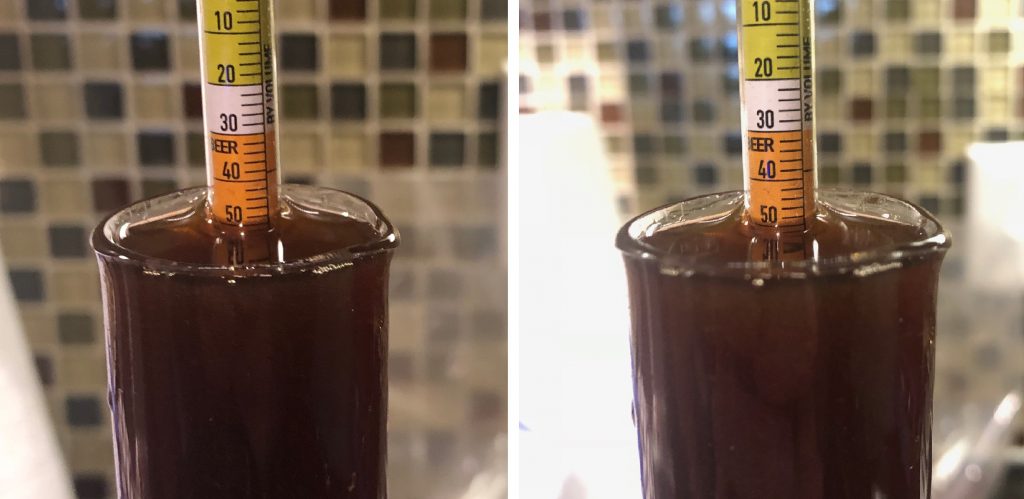
Equal volumes of wort were transferred to identical PET carboys.
I placed foil atop each carboy and placed them in fermentation chambers, at which point I could already see a difference in color.
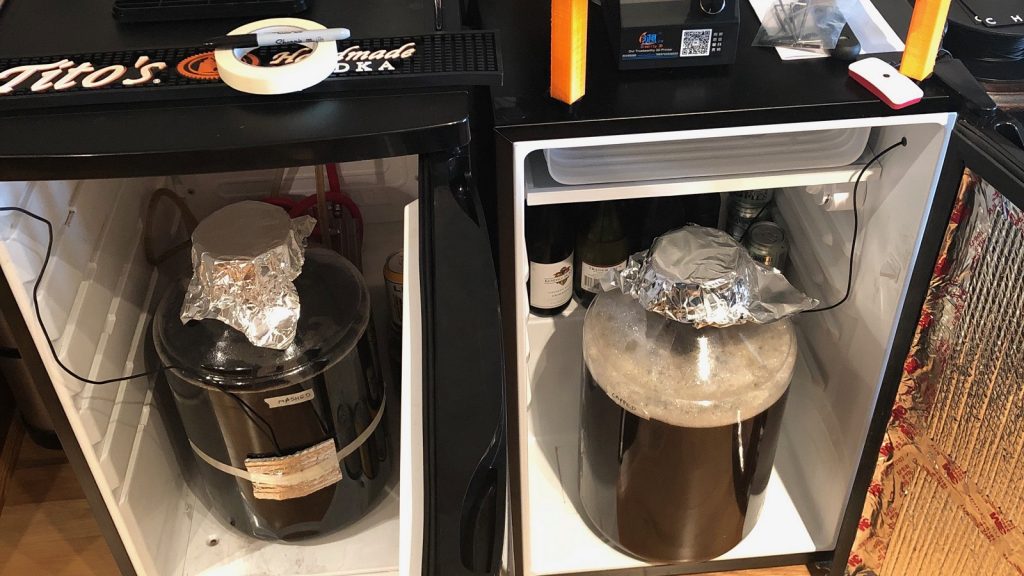
I let the worts chill overnight to my desired fermentation temperature of 50°F/10°C before pitching a pouch of Imperial Yeast L13 Global into each batch.
Signs of fermentation were evident in both batches 24 hours later. After a few days, I raised the temperature 60°F/16°C for a diacetyl rest and let them finish out. Hydrometer measurments taken 11 days later showed both beers finished at the same 1.012 FG.
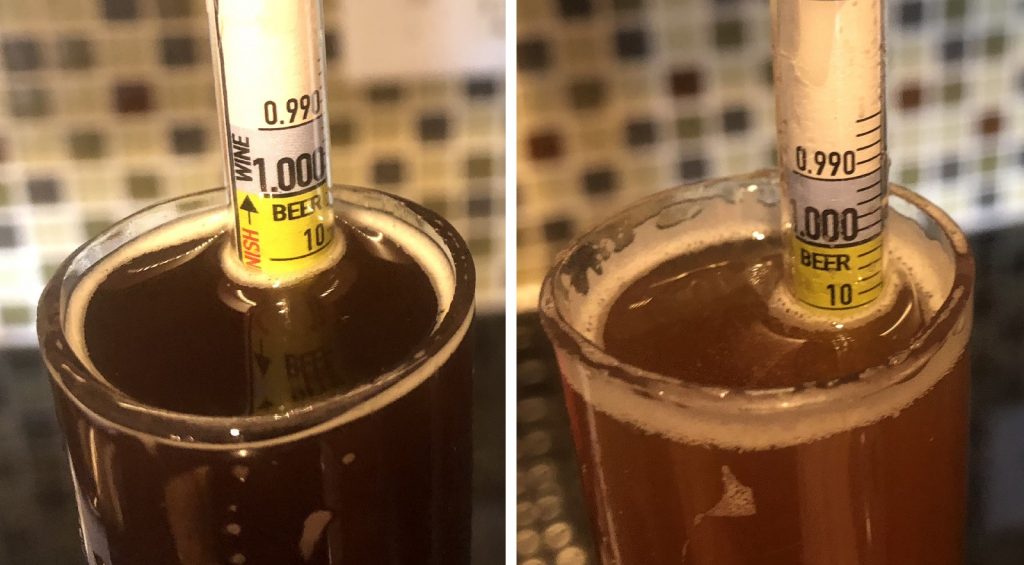
After transferring the beers to kegs, they were burst carbonated and left to condition for a few days before I served them to tasters. Unfortunately, I forgot to get pictures of the finished beers. Suffice to say, there was a noticeable color difference between them, the full mash beer being darker and more opaque than the capped mash version.
| RESULTS |
A total of 18 people of varying levels of experience participated in this xBmt. Each participant was served 2 samples of the beer made with roasted grains included in teh full mash and 1 sample of the beer made with roasted grains added during the sparge in opaque cups then asked to identify the unique sample. While 10 tasters (p<0.05) would have had to accurately identify the unique sample in order to reach statistical significance, a total of 12 did so (p=0.004), suggesting participants in this xBmt were able to reliably distinguish a Schwarzbier mashed with roasted grains in the full mash from one where the roasted grains were added at the sparge step.
My Impressions: Out of the 5 semi-blind triangle tests I attempted, I accurately identified the unique sample every time. To me, the capped mash beer seemed drier and crisper with a more balanced roasted malt flavor than the full mash version. which I felt was too roasty for a Schwarzbier. Neither beer was bad, just different.
| DISCUSSION |
Roasted flavors including coffee and even slightly burnt toast are expected in certain styles of beer where good portions of darker malts are used. Unfortunately, the grains used to produce such styles can also impart acrid flavors that taste more like burnt ash than the clean roasted characteristics brewers are after. It’s been posited these generally undesirable flavors are a function of how long the roasted grains spend in the hot mash, with shorter contact time leading to less harshness. Seeing as the enzymes in roasted grains are denatured in the roasting process, they don’t require mashing, hence some brewers have taken to adding them toward the end of the mash rest or during the sparge step to reduce the risk of astringency. Indeed, participants in this xBmt were able to tell apart a Schwarzbier made with roasted grains in the full mash from one where the roasted grains were added just before sparging.
With these results corroborating those of a previous Brülosophy xBmt on the same subject, it would seem adding roasted grains at the vorlauf or sparge step really does lead to a perceptible difference. I didn’t gather data on what it was about the the beers that helped tasters distinguish them, but based on my own anecdotal experience, the capped mash version had a smoother roast character, which may or may not be preferred. In fact, while the softer roast worked great for a Schwarzbier, it’s possible employing this method on styles like Porter and Stout may lead to a less desirable outcome.
One thought I had when comparing these beers is whether other not I could achieve similar results by simply using less roasted grains in a full mash. Doing so would lead to less color, as observed in the capped mash beer, as well as less overall roast character, which could include astringency. While I plan to continue experimenting with this method, and despite having a slight preference for the capped mash beer in this xBmt, including all the grains in the full mash is easier on my system, so that’s the method I’ll be sticking with.
| About The Author |
 Richard Westmoreland is a homebrewer from Houston, TX who got his start in 2015 with a 1 gallon extract kit. After his first batch, he was hooked and decided to dive headfirst into all grain brewing. Richard currently brews multiple batches per month on a Robobrew 3-in-1 electric system and is the inventor of the WiFerm Temperature Controller .
Richard Westmoreland is a homebrewer from Houston, TX who got his start in 2015 with a 1 gallon extract kit. After his first batch, he was hooked and decided to dive headfirst into all grain brewing. Richard currently brews multiple batches per month on a Robobrew 3-in-1 electric system and is the inventor of the WiFerm Temperature Controller .
Would you like to have your experiment featured on Brulosophy.com? Join The Brü Club today! The Brü Club is a growing community of curious homebrewers who regularly engage each other. Learn more at TheBruClub.com !
If you have any thoughts about this xBmt, please do not hesitate to share in the comments section below!
Support Brülosophy In Style!
All designs are available in various colors and sizes on Amazon!
Follow Brülosophy on:
FACEBOOK | TWITTER | INSTAGRAM
If you enjoy this stuff and feel compelled to support Brulosophy.com, please check out the Support page for details on how you can very easily do so. Thanks!

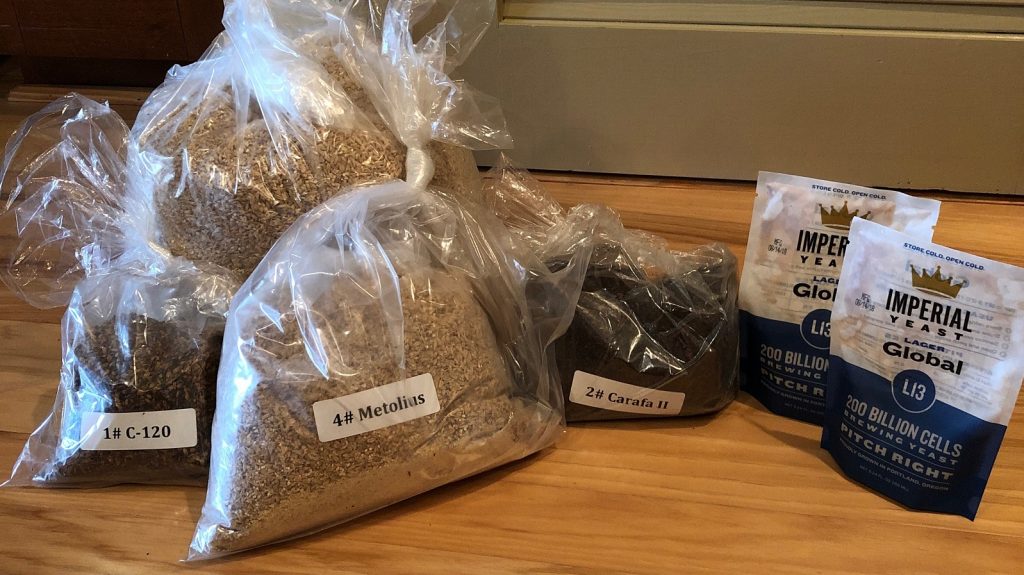
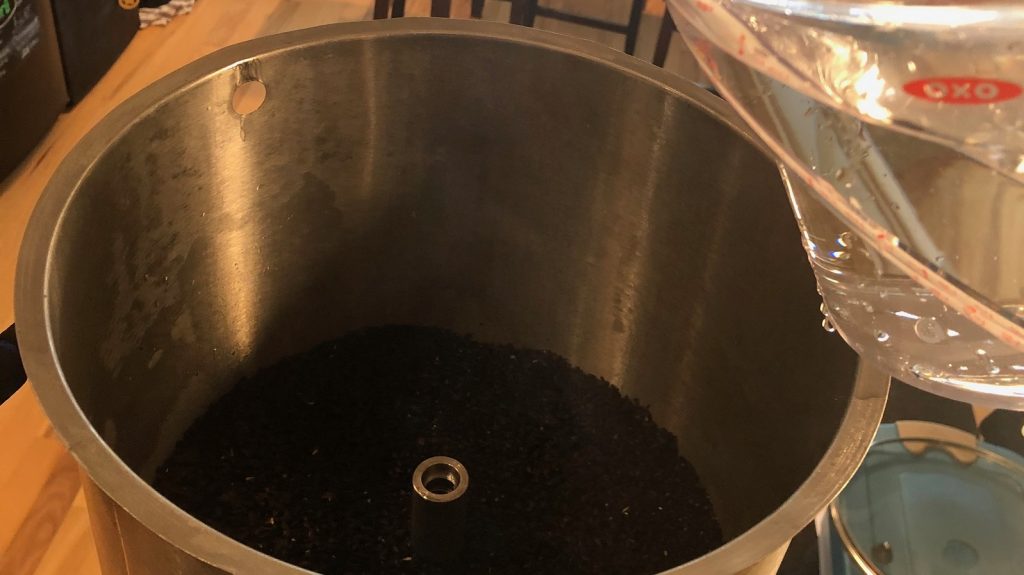
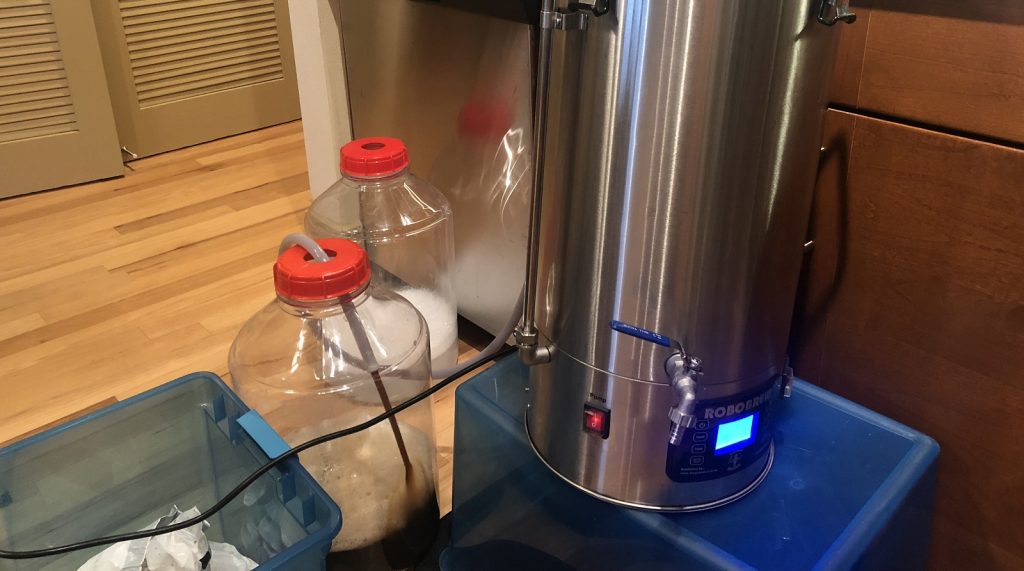
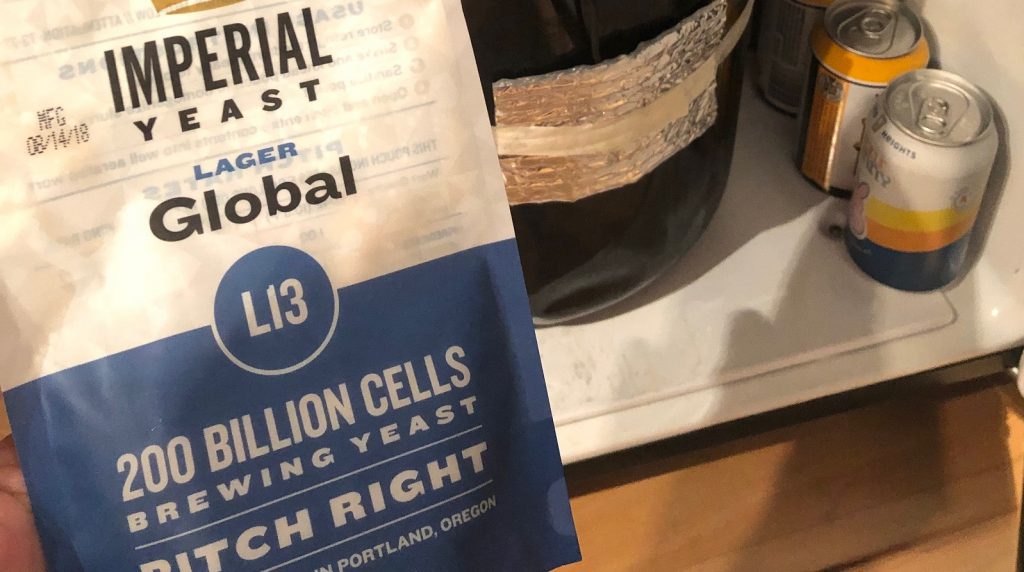










28 thoughts on “The Brü Club xBmt Series | Roasted Grains: Full Mash vs. Capped At Sparge”
“`While 10 tasters (p<0.05) would have had to accurately identify the unique sample in order to reach statistical significance, a total of 12 did so (p=0.004), suggesting participants in this xBmt were unable to reliably distinguish a Schwarzbier mashed “`
Is 12 the wrong value here? 12 would suggest significance right?
I think he typed “unable” by mistake. It should be “.. were able to …”
Noticed the same thing, seems like a typo on “unable”
Otherwise well written, I too assume a typo.
(Also not surprised at results 🍺)
Saw that too. And then he says he picked the odd beer out 5/5 times. Clearly there is a difference from his description. Wish he had asked those 12 about preference.
I have some preference data. Let me get back to you with that once I’m in front of a computer.
I reread that sentence like 10 times before deciding that it must be a typo.
Typo fixed. Numbers were correct, “unable” was wrong.
Oops! Probably a typo. I think someone fixed it 🙂
Regarding the reason why roasted grains don’t need to be mashed- it’s not because their enzymes have been denatured, but because they don’t contribute much starch that needs to be digested before fermentation. Someone please correct me if I am mistaken!
I was about to say something similar.
2 questions for you:
1. What color Crystal malt?
2. Did you use Carafa special, or regular Carafa?
The answer is in one of the pictures. Look closely at the grain bags.
The same photo that shows L13 yeast, instead of L17?
Question for you: what was the group’s preference?
The significance of the experiment must be questioned with such a dramatic difference in color. Visual cues can have a very strong influence on perceived sensory data impressions. It would not be surprising to see a sample bias related to people “tasting” greater roast character in a darker beer. That bias could be mitigated if the subjects were truly blind to the beers being tasted.
Looks like they served the samples in opaque cups.
Did you adjust the water chemistry between the two batches? Did you happen to measure the mash pH? I would expect before mash do you had a lower pH in that may have been a contributing factor. When I use this technique one of the benefits is it the water chemistry for the capped approach is simpler. Alternatively, I actually prefer making a cold tea from the dark grain. I also increased the dark grain load by 50%.
My apologies for not proof reading, this will make more sense:
Did you adjust the water chemistry between the two batches? Did you happen to measure the mash pH? I would expect the full mash to have a lower pH and that may have been a contributing factor. When I use this technique one of the benefits is the water chemistry for the capped approach is simpler. Alternatively, I actually prefer making a cold tea from the dark grains. I also increased the dark grain load by 50%.
I adjusted the water / mash ph for each “full mash” so ph with the mashed roasted grains was the same as the mash without the roasted grains.
“… I sprinkled the finely ground roasted grains on top of the grainbed and began the sparge step.”
Did you mill the dark grains differently? And or how did you finely grind? I did this a few months ago, added the dark grains at vorlauf, similar results, color was certainly off and mouthfeel was low, it was a stout.
I was thinking the inverse of your thought to add more dark grains to boost color and mouthfeel of the capped at sparge method.
I used the same crush for the vorlauf. I agree with you. I’ll grind finer and use a little more if I do this again.
Of the 12 who tell a difference, how many preferred each beer?
I’d love to know if you fly sparge or batch sparge with the capped version. Thanks!
I use an electric all in one system so I guess you would say I “batch” sparge. I just pour water on top – no stirring. So maybe a batch / fly hybrid?
With such a large difference in color, I wonder how much of the difference is coming from a real difference in the roast character due to the different processes vs. just a difference in the efficiency of extracting the roasted grains between the different methods. In other words, if more roasted grain were used in the mash capped beer to match color between the 2 beers, would there still be any perceivable difference?
I was wondering the same, if the colour isn’t at full strength then it’s safe to assume that flavour isn’t either – hence you can’t really compare the two beers except to say that the capped method is less efficient when it comes to extraction.
I feel a cold steep is a better method if trying to avoid those strong flavour characteristics, but still you usually have to increase the amount of dark malts by up to double for that method (and probably for the capped method too) in order to hit the colour.
Would be interesting to see if for the batch where dark malts was added during sparge, if increasing the dark malts by a certain percentage would get you closer to the color of the full mashed batch.